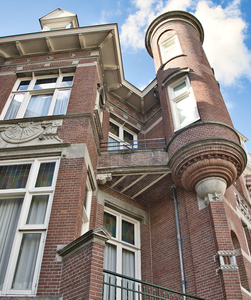Property 14 — Simplicity and Inner Calm
Simplicity and Inner Calm is introduced in
Some forms cannot be calm or simple. What they are about is their complexity. Examples include patterned wall coverings or other decorative elements. However, some things must gain this property as they grow in size. They must simplify, attain an essence of eternity, and begin to emanate a sense of stasis. Not stuck or dead, but steadfast, unshakeable, and waiting. Noisy things do not seem to have this. Simplicity comes first, then calm.
When a large object, or at least one that dominates a space, has too much character, we want to slow it down and mute its harshness. As beautiful as they are, many Western buildings constructed as a form of praise do not have this property. They have too many parts that seem like they are still in motion. The buttresses are flying, and the friezes are not frozen. The details mean there is nothing on which you can rest your eyes and defocus.
The good examples in architecture are abound with columns and massive stone structures but also with things that are not so much large as they are simple and not heavily ornamented. The inclusion of fewer details magnifies the apparent size of these simple things. We find the opposite in buildings with haste in their lines. They may be adorned with facets that work well but never catch a breath. They are, therefore, not calm.
This calmness can be the difference between word processors and distraction-free writing applications.
In
- It uses very simple shapes.
- The ornament is very sparse, but is occasionally present …
- The proportions are unusual. Elongated, high, long, tall, broad, etc, but for practical reasons such as to use all the available space.
- Strange in some specific way, such as unexpected openings or additions. In effect, emphasising an extreme freedom to do what needed to be done.
- Coloured in a deep way. Right into the wood. Not painted.
- Finally, everything is still, silent.
These properties generate inner calm in Shaker furniture. We can think of some of these points as not responding to judgement, not caring about appearance but being its authentic self. The mood is all about having a duty and performing it in the best possible way despite tradition or other expectations. This inner calm is a respect for itself and confidence to exist.
 Eclectic style, not calm, not simple.
Eclectic style, not calm, not simple.
For negative examples, consider the inclusion of a parapet on a modern building. It’s an old form, but it is not in keeping with the theme. It marks itself as quirky and actively different. This is the difference between an eccentric who wears their dressing gown when going out in public simply because it’s comfortable and the ‘look how random I am’ teenager who wears odd shoes as a form of self-expression.
So, inner calm does not exist in wacky objects, whether in architecture, furniture, art, or rugs. Elements that break from tradition for the sake of breaking are not calm. They are tense, waiting to see a reaction. They become dependent on the observer and are weakened by this neediness because they are for something other than their own completeness.